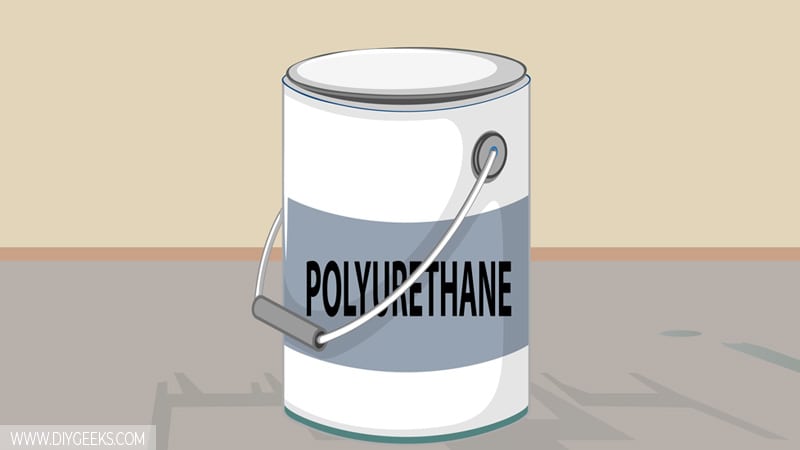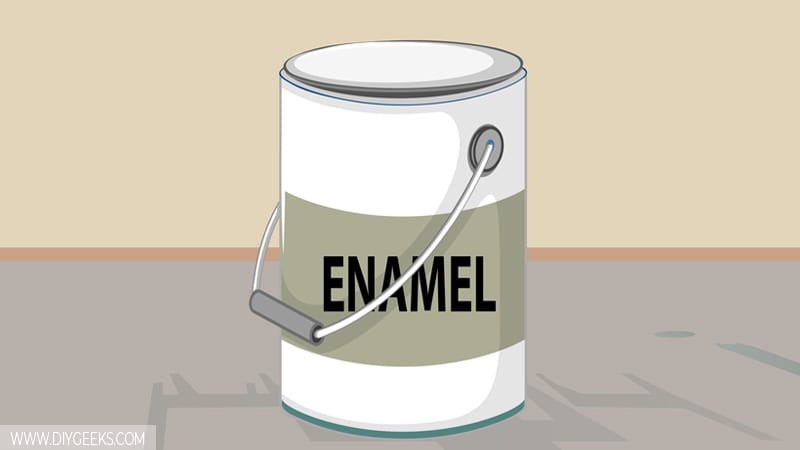Polyurethane is a plastic-like protective coating that is used to protect surfaces from water, moisture, scratches, or weather elements. Enamel paint is an oil-based finish that forms a colorful finish over surfaces and offers low resistance to moisture or water.
Polyurethane is more durable, moisture-resistant, and offers better wood protection than enamel paint. Enamel paint forms a colorful finish, costs less, and beautifies (or enhances) the wood’s appearance.
What is Polyurethane?

Polyurethane is a transparent (colorless) protective coating that protects several surfaces from moisture, water, scratches, and weather elements. It forms a glossy moisture-resistant plastic-like layer (barrier) that prevents water penetration.
The term polyurethane comes from the word ‘urethane’, a compound with plastic features. Urethane is the main ingredient, which is why its finishes usually have plastic features.
Related Read: Can You Apply Polyurethane Over Enamel?
What is Enamel Paint?

Enamel paint is an oil-based finish obtained from a petroleum spirits and resinous compound combination that forms a hard and glossy finish over several surfaces.
Enamel paint has a thick viscosity and takes longer to dry than most paint — it takes around 6 hours to dry between coats. Since the paint takes longer to dry, it produces a more durable finish because the particles and binder have more time to harden, bond, and cure.
Polyurethane vs Enamel Paint
The differences between polyurethane and enamel paint are listed below.
Durability
Polyurethane is more durable and lasts longer than Enamel paint as it’s formulated with more protective additives that make its finish moisture-resistant.
Enamel paint is durable too, but its finish doesn’t last long if exposed to constant water or weather elements.
Finish Color Shade
Polyurethane forms a colorless (transparent) finish color shade, while enamel paint forms a colorful finish.
Polyurethane doesn’t have paint pigments on its formula, so it forms a colorless (transparent) finish that doesn’t affect the underlying surface or paint color shade. Tinted polyurethane forms a glossy colorful finish that covers the underlying surface color.
Enamel paint forms a colorful finish because it’s formulated with paint pigments.
Moisture Resistance
Polyurethane is more moisture-resistant than enamel paint because it’s formulated with more protective additives and forms a glossy plastic-like finish that prevents water penetration.
Enamel paint offers low moisture-resistance levels as its finish can be removed if exposed to constant water or moisture.
Wood Protection
Polyurethane offers better wood protection than enamel paint.
Polyurethane forms a glossy moisture-resistant layer (barrier) over the wood and protects it from moisture, water, scratches, and weather elements. Its finish doesn’t penetrate the surface pores, so it forms a protective layer (barrier) over the surface.
Enamel paint forms a low moisture-resistant coating over the wood and protects it from low moisture, water, or scratches. The paint can’t offer good protection to exterior wood surfaces or already painted (or sealed) wood.
Cost
Polyurethane costs more than enamel paint as it offers more protection, is more durable, and has more qualities.
Usage and Purpose
Polyurethane is used to seal and protect surfaces from moisture, water, scratches, and weather elements. Enamel paint is used to enhance and beautify the wood’s appearance and offer low protection.
The Finish
Polyurethane forms a glossy transparent moisture-resistant finish that doesn’t alter the underlying surface color shade. Its finish does appear a bit glossy or reflective when dried fully.
Enamel paint forms a glossy colorful finish over different surfaces. The paint covers the surface’s natural look and offers low moisture-resistant protection. In simple words, enamel paint is used to beautify and protect low-traffic surfaces.
Which Finish Do You Need?
If you are still stuck with your decision, here are a few factors that will make the decision easier:
- Budget: Use enamel paint if your budget is low.
- Maintenance: Use polyurethane as it’s easier to clean and maintain than enamel paint as it doesn’t attract dust or filth.
- Dry Time: Enamel paint dries faster than polyurethane.
- Durability: Use polyurethane if you want a durable finish that protects the surfaces from constant water or moisture.
- Surface Type: Use enamel paint for low-traffic interior surfaces and polyurethane for exterior high-traffic surfaces.


